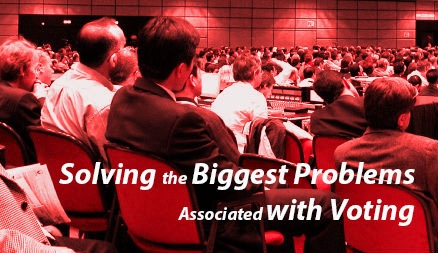
Voting procedures in public meetings can be long, arduous, and cumbersome, especially when participation is high and manpower is limited.
There are many methods of voting including standing counts, raising hands, voice votes, paper ballots, and roll calls; each with their own unique challenges associated with them. However, the biggest problems they all share are time constraints, privacy concerns, voting security, and voting count inaccuracies.
The solution is simple: Electronic Voting!!
Electronic Voting is Fast... Electronic voting with wireless keypads is fast! State of the art audience response systems gather data from the audience every 3 seconds. The entire audience typically responds in about 20 to 30 seconds and results are tabulated immediately. There is no time wasted with standing counts or collecting and tabulating paper ballots.
Traditional voting procedures require extensive time dedicated to the tallying and logging of votes. This not only increases the chance for error but also reduces the amount of time available to be spent on the actual meeting debate topic. After the meeting is over, electronic voting systems allow for an instant report of results that can be easily viewed and published immediately.
Electronic Voting is Private...Electronic voting systems maintain privacy. There is no need for standing, speaking, or raising hands. Not only does this make voting easier for those with physical challenges, but it prevents anxiety and fear of reprisal when votes are disclosed.
Electronic voting ensures that responses are more genuine and align with the true preferences of the voters attending a meeting. This helps to create higher response and attendance rates, as well as higher validity, by eliminating qualms individuals have of being judged if their votes are publicly disclosed..
Electronic Voting is Secure...Electronic voting with an audience response system is secure. Each vote is transmitted via encrypted wireless transmission and confirmed personally to each voter. Radio signals are encrypted using special proprietary algorithms. Every transmission uses frequency hopping spread spectrum protocols that make it very hard to hack the system or interfere with it.
Electronic Voting is Accurate...Electronic voting requires everyone in attendance to use a voting keypad or smart device. These keypads each transmit a unique encypted ID number associated with only one person. Each voter receives a confirming message.
Because these keypads will only count the last vote entered, they eliminate errors associated with a person's vote being counted more than once. Electronic voting can reduce the potential for unauthorized votes that can occur in a standing vote count. It eliminates the uncertainty of a voice or hand vote that is not decipherable.
They're also as simple to use as pressing a button! Wireless response keypads are distributed to voters. When the Moderator announces that voting is open, each voter can then press the button on his or her handset that correlates with their decision. Only one vote is recorded per person – the last vote they cast before the voting period closes. This allows for users to change their vote in case they pressed the wrong button or simply changed their mind.
After the voters make their selection, the handset transmits the response to a central computer receiver. Once the tabulation is complete, the handset will display a confirmation to let the user know that their vote was received.
Several hardware and software solutions for electronic voting are available for rent or purchase. ARS systems for electronic voting can scale from 10 people to as many as 15,000 voters in a single venue. You can learn more about the different configurations for public meetings by clicking the button below.


